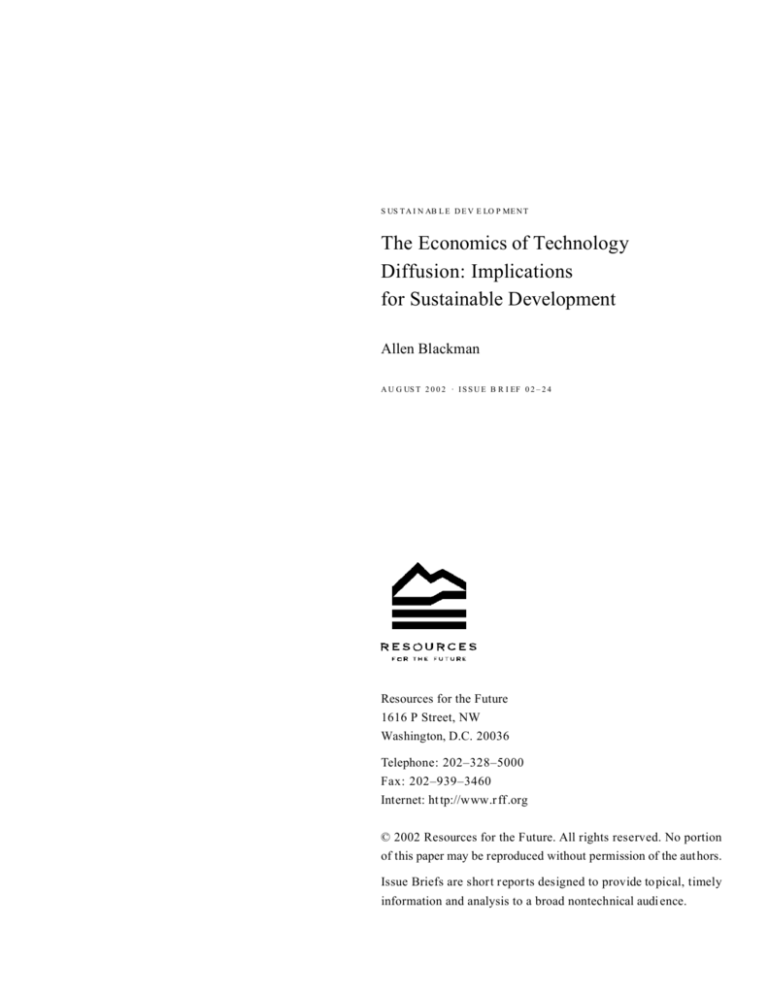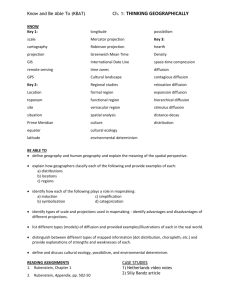The Economics of Technology Diffusion: Implications for Sustainable
advertisement

S US T A I N AB L E D E V E LO P ME N T The Economics of Technology Diffusion: Implications for Sustainable Development Allen Blackman A U G US T 2 0 0 2 · I S S U E B R I EF 0 2 – 2 4 Resources for the Future 1616 P Street, NW Washington, D.C. 20036 Telephone: 202–328–5000 Fax: 202–939–3460 Internet: ht tp://www.r ff.org © 2002 Resources for the Future. All rights rese rv ed. No portion of this paper may be reproduced without permission of the aut hors. Issue Briefs are shor t reports designed to provide to pical, timely information and analysis to a broad nontechnical audi ence. Introduction Environmental protection in many developing countries is hamstrung by a scarcity of financial and institutional resources. An increasingly popular strategy for overcoming this obstacle is to promote the diffusion of environ me nta lly friendly technologies (E FTs). Some EFTs—nota bly, energy efficiency innovations—both reduce pollution and cut production costs. The hope is that developing country firms and farms will adopt such technologies voluntarily, or at least with minimal prodding, obviating the need for government financing and regulation. Environmental management strategies that focus on EFTs generally garner widespread suppor t since they represent oppor tunities to enhance productivity and improve environmental quality in the eyes of developing country policy ma kers, and oppor tunities to boost exports of equipment and expertise in the eyes of industrialized country policy makers. But how likely is it that technology-based strategies will have a significant impact on environmental quality in the near to medium term? In part, the answer depends on whether, once introduced, EFTs would diffuse at a reasonably rapid pace, and whether policy makers will be able to speed the rate of diffusion. This brief article summarizes some of the key findings of the extensive economics lit erature on the diffusion of new technologies, and assesses the implications of these findings for technology-based pollution control strategies. In shor t, the literature suggests that a wide variety of policies are likely to speed the diffusion of EFTs, including rationalizing en ergy prices, improving information, and investing in energy infrastructure. The Economics Of Technology Diffusion Although not all the evidence on tech nology diffusion is conclusive, there is broad agre ement on two points. First, new technologies are never adopted by all pot ential users at the same t ime. The widespread diffusion of new technologies can take anywhere from five to fifty years. Second, countless studies have conf irmed that the diffusion of new technologies follows a predictable intertemporal pattern—technologies are ado pted rather slowly at first, then more rapidly, and then slowly again as a techn ol o gy specific “adoption ceiling” is reached. These stylized f acts have prompted researchers to focus on two related questions: Why do some firms adopt a given innovation before oth ers? Why do s ome innovations diffuse more quickly than others? Researchers have addressed these questions using a variety of theoretical constructs that emphasize different aspects of the diffusion process. “Epidemic” models focus on the dissemination of information about new technologies via day-to-day cont act among firms, likening this process to the spread of a disease. These models imply that some firms adopt be fore others because they happen to become “infected” first, and that some innovations diffuse faster than others bec ause they are more “contagious” than others by vir tue of their profitability and limited riskiness. So-called “rank” models are premised on the ob se rvation that, given differences in capital vintage, size, access to technical in formation, labor productivity, and environmental regulatory costs, some f irms will get a higher return from a new technology than others. Hence, one may rank all potential adopters on the basis of their expected returns. Only firms with a sufficiently high ranking will adopt when an innovation f irst bec omes available. However, over time—as sector-wide production and information costs fall, the new technology is refined, and the existing capital depreciates—lower ranked firms will adopt as well. 2 Resources for the Future ·Issue Brief “Order” models are applicable when there is a fixed critical input into production such as a pool of specially tra ined labor or a scarce natural resource. In such situations, the order of adoption c learly matters—initia lly only f irst movers who secure access to the critical input will find it profitable to adopt. Finally, so-called “stock” models are also premised on the idea that early movers obtain higher returns on the new technology. However, they attribute t his phenomenon to the fact that as the stock of firms that have adopted a cost-saving innovation grows, average production costs fall, and eventually output prices fall as well. Thus, initially it will only be profitable for a limited number of f irms to adopt. It is important to note that these four types of theoretical models are not mutually exclusive. Indeed, the diffusion of any specific technology is likely to be influenced by some combination of the factors emphasized by the models: information and learning, the characteristics of potential adopters, the characteristics of technology, the scarcity of critical inputs, and the sensitivity of output prices to technological change. Most empirical (versus theoretical) investigations of technology diffusion have sought to understand exactly how characteristics of new innovations and of potential adopters influence diffusion (thus, they essentia lly constitute tests of the rank model). They have found that, not surprisingly, relatively profitable, small-scale, and simple innovations are adopted fastest. In addition, they have found that new technologies are adopted fastest by firms that are large, have well-trained staff, incur high regulator y costs when using an existing techn ol o gy, have infrastructure complementary to the new technology, are in fas t-growing industries, invest more in R&D, pay relatively low prices for inputs used intensively by the new technology, and have relati vely old existing capital. Despite considerable research, the ev idence regarding the impact of market structure (the degree to which the market is c ompetitive or controlled by a small number of firms) on the timing diffusion is inconclusive. Policy Prescriptions What does the current state of knowledge suggest for technology-based climate change policy? Two implications are immediately obvious. F irst, even if EFTs that significantly lower production costs are made available in developing countries, diffusion will not be immediate. Second, developing country firms will not necessarily rapidly adopt EFTs simply because they reduce production costs in industrialized countries. A broad range of firm-level, sector-level, and countrylevel char acteristics determine whether or not and how quic kly new technologies are adopted, and there are likely to be systematic differences between developing countries and industrialized countries in nearly all of these characteristics. To give one example, labor is generally much less costly relative to capital in developing countries. Therefore, labor-saving technology that is profitable in industrialized countries will not necessarily be profitable in developing countries. In addition, it is important to note that faster diffusion of a technology is not necessarily beneficial. As Stoneman and Dierderen point out (see Further Readings), diffusion may be “too fast” if f irms adopt a technology before it is profitable to do so, or if firms adopt a new technology today that effectively preempts the adoption of a superior technology in the future. Given the theor y and evidence presented above, there would seem to be seven types of policy levers available to influence the speed of diffusion of EFTs in developing countries. These con- The Economics of Technology Diffusion: Implications for Sustainable Development 3 cern: information, input prices, regulation, credit, subsidies, human capital, infrastructure, research and development, and intellectual proper ty restrictions. Information. Economic theor y suggests that the dissemination of information about the new technology is likely to be a critical determinant of diffusion. (Limited empirical suppor t for the impor ta nce of information probably stems only from the difficulty of measuring information flows.) As Stoneman and Dierderen make clear, government intervention to enhance the dissemination of technical information is likely to be justified since v ir tu al ly every means by which firms acquire information about new technologies is imp erfect. When firms acquire tech nical information through day-to-day cont act with other firms, early adopters supply information about the new technology to later adopters, but the former do not capture any of the benefits from this information transfer th emselves. As a result, they do not have proper incentives to make this information available to their rivals. When firms acquire technical information through active search, firms op erating independently will engage in inefficient duplication of search ef forts. And finally, when firms acquire tech nical in formation from adver tising, technology supp liers who are con ce rned about market share, not the diffusion of the techn ol o gy, have incentives to oversupply technical information, which may lead to too-rapid diffusion of intermediate technology. Policy options for enhancing the flow of information about new technologies include demonstration projects, advertising campaigns, the testing and cer tification of new technologies, a nd subsidies to technological consulting s ervices. Have such mechanisms had a verifiable impact on diffusion? Demonstration projects have received wide application in the contex t of developing country agriculture, and many industrialized countries have set up regional information clearinghouses to provide consulting s ervices to small- and medium-sized bus inesses that presumably can least af ford search costs associated with adoption. As yet, however, evaluations of these programs have been limited, and we know little about their effectiveness.* Finally, it is worth noting that informatio n-based polices may act ually retard diffusion by fostering the expectation that improved technologies are forthcoming, and therefore creating incentives to defer adoption. A similar problem arises when public provision of information about new technologies crowds out private informatio n. Input Prices. Both theor y and evidence attest to the important role that input prices play in the diffusion of new technologies. In particular, energy prices clearly have a critical impact on the adoption of energy saving tech nologies. In a number of developing and reforming economies, energy is still subsidized. Removing or significantly scaling back energy subsidies in these countries would create strong incentives to adopt energy-saving technologies. In countries where energy prices are not subsidized, taxing energy to raise its effective price above the market price would have the same effect as removing subsidies. Regulation. As noted above, empirical research suppor ts the hypothesis that firms subjected to stricter environmental regulation are more likely to adopt clean technologies, including EFTs. The oppor tunities for, and barriers to effective regulation in developing countries have received * For example, the US Depar t me nt of Commerce sponsors a net work of “Man u fa cturing Technology C enters.” Similar net works have been established in the United Kingdom (the Advanced In formation Techn ol o gy Programme, and the Regional Office Technology Transfer Programme), in France (Centres R egionaux dÕInnovation et de Tra nsfer de Techn ol o g ie), and in the European Union (the SPRINT programme). 4 Resources for the Future ·Issue Brief considerable attention, especia lly in the last ten years. Two points deserve mention. F irst, the use of market-based incentives such as pollution ta xes and marketable permit systems is analogous to raising the price of a critical factor of pr oduction, namely environmental s ervices. Therefore, the same arguments about the link between factor prices and technology adoption are applicable. Second, even when institutional and f inancial co nstra ints make formal public-sector-led regulation problematic, private-sector-led “informal” initiatives (such as grassroots ef for ts to deter polluters by st igmatizing them) can be an effective substitute. Credit. Lack of access to credit may be a critical barrier to adoption. Subsidizing credit for specific types of investments has been a common policy response. However, thus far these programs—both public and private—have had very mixed results. Chronic problems include the diversion of loans by borrowers to no n-targeted activities, low repayment rates, the creation of fin an cially unsustainable lending institutions, politicization of lending decisions, and the undermining of existing credit markets. Since there is growing suppor t for the view that the costs of “targeted” credit outweigh the benefits, a wiser approach to overcoming financial barriers to technological in novation may be to focus on improving banking which, in developing countries, is often constra ined by unstable monetary policy, interest rate restrictions, and weak property rights. Subsidies. An o bvious mechanism for speeding the diffusion of a new technology is for governments to subsidize it. But subsidies—in addition to being quite expensive—are likely to be subject to many of the same problems as targeted credit, namely the politicization and distortion of input markets. Human Capital, Infrastructure, and Research and Development. Empirical research on the links between early adoption of innovations on the one hand and human capital, infrastructure, and research and development (R&D) on the other suggests there is an argument for subsidizing education, technical training, infrastructure and R&D. This needn’t be a broad-brush strategy if these subsidies are focused on pollution-intensive sectors such as energy. Intellectual Property Restrictions. Intellectual property restrictions such as patents and licenses have countervailing effects on technology diffusion. On the one hand, they stimulate R&D, which in turn stimulates technology diffusion. Perhaps more important for developing countries, they are likely to encourage foreign in vestment, w hich can be a significant source of new technologies. But on the other hand, intellectual property restrictions attach significant costs to adopting new technologies which can retard diffusion. In many developing countries, adaptation of existing tech nologies, rather than the creation of substantially new ones, accounts for the bulk of productivity growth. Therefore, there is reason to suspect that the negative impact of intellectual proper ty restrictions on diffusion in developing countries could be substantial. Practical First Steps Of the broad range of policy options presented h ere, which are likely to be politically practical? As m entioned in the introduction, technology-based strategies will generate po litical suppor t to the extent they represent obvious “win-win” oppor tunities for the parties involved. Many of the policies described above fit this description to some degree. Information, human capital and infrastructure policies will enhance productivity; rationalizing energy prices will boost allocati ve The Economics of Technology Diffusion: Implications for Sustainable Development 5 efficiency; improving ba nking should stimulate saving and investment; and strengthening regulation should produce env ironmental benefits. However, some of these policies involve up-front economic costs that are more immediate and payoffs that are more delayed than others, making them unattractive to decision makers with shor t t ime horizons. For example, t hough invest me nts in banking, human capital (broadly defined), and env ironmental regulation may have tremendous benefits in the long run, they involve substantial up-front costs. Thus, the most practical policy options di scussed here would seem to be rationalizing energy prices, improving information, and investing in energy infrastructure. Further Reading General Interest Ston eman, P. 1991. “Technological Diffusion: The Viewpoint of Economic Theor y,” in Mathias, P.; D avis, J., eds., Innovation and Technology in Europe: From the Eighteenth Century to the Present Day. The Nature of Industrialization series; Oxford and Cambridge: Bl ackwell, pp. 162 - 84 . World Bank. 1992. World Development Report: Development and the Environment, 1992. Washington, DC: Oxford U. Press. More Technical Content B la ck man, A. 1997. “Economic Research on Technology Diffusion: Implications for Developing Country Climate Change Policy.” Mimeo, Resources for the Future: Washington, DC. Ecc hia, G. and M. Mariotti. 1994. “A Survey on Environmental Policy: Tech nological Innovation and Strategic Issues.” Fondasione Eni Enrico Mattei EEE Working Paper 44.94, Mila no. Karsh enas, M. and Ston eman, P. 1993. “Rank, Stock, Order and Epidemic Effects in the Diffusion of New Process Technology.” Rand Journal of Economics, 24(4), 503-527. Kemp, Renè. 1997. Environmental Policy and Technical Change. Bro ok field, VT: Edward Elgar. Mansfield, E. 1968. Industrial Research and Technological Innovation. New York: W.W. Norton. Pargal, S., and D. Wheeler. 1996. “Informal Regulation of Industrial Pollution in Developing Countries: Evidence from Indonesia.” Journal of Political Economy, 104(6), 1314 - 27 . Ston eman, P. 1983. The Economic Analysis of Technological Change. New York: Oxford University Press. Ston eman, P. and Diederen, P. 1994 (July). “Techn ol o gy Diffusion and Public Policy,” Economic Journal 10 4(425), pp. 918 - 30 . * For example, the US Depar t me nt of Commerce spon so rs a network of “Manufacturing Technology Centers.” Similar net works have been established in the United Kingdom (the Advanced In formation Techn ol o gy Programme, and the Regional Office Technology Transfer Programme), in France (Centres Regionaux d’In novation et de Tra nsfer de Techn ol o g ie), and in the European Union (the SPRINT programme). Allen Bl a ck man is a RFF fellow. Note: t his piece originally appeared as RFF Climate Issues Brief No. 5 and was published in September 1997 (revised August 2002)] 6 Resources for the Future ·Issue Brief









